May 22, 2025 | 08:57 GMT +7
May 22, 2025 | 08:57 GMT +7
Hotline: 0913.378.918
May 22, 2025 | 08:57 GMT +7
Hotline: 0913.378.918
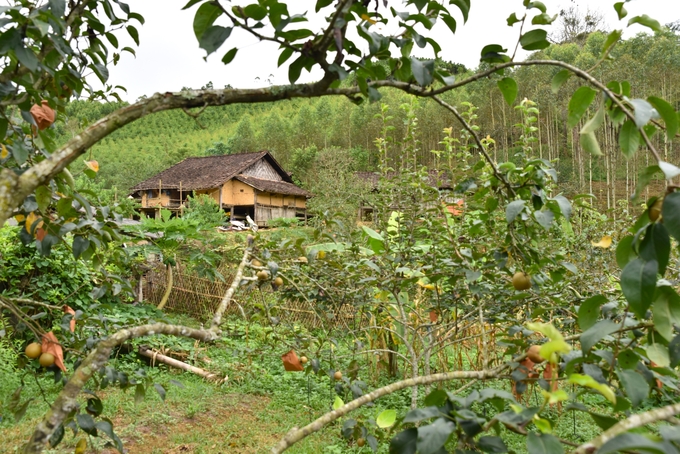
Mr. Hoang Van Khi's house overlooks the pear garden. Photo: Duong Dinh Tuong.
Dr. Le Thi My Ha (Institute of Fruit and Vegetable Research) gingerly patted the trunks of several trees and gazed at them with affection. She had grafted a different variety of pear, which was small and of poor quality, and entirely altered the canopy structure. Originally, these trees were of poor quality.
Since 2015, Dr. Ha's research team has assisted garden proprietor Hoang Van Khi in Na Khau hamlet, Doi Can commune (Trang Dinh district, Lang Son province) in the grafting and renovation of numerous pear trees. A total of six varieties of pear trees were imported from Taiwan. Not only do they possess exquisitely balanced canopies following transplantation, but they also produce numerous high-quality fruits. These are the spiritual offspring of the scientists.
In Lang Son province, the local temperate fruit trees consist of persimmons, which are found throughout the Van Lang district, Bao Lam persimmons, which are prevalent in the Bao Lam commune of Cao Loc district, and a variety of other fruits, such as wild plums, brown pears, and green pears. The locals have spontaneously developed the economic value of each tree type, particularly the extensive wild plum plantations in the Van Quan, Cao Loc, and Van Lang districts, which generate substantial income. With an area of approximately 2,500 hectares, persimmons have emerged as a critical commodity in the Van Lang district.
The pear trees are more scarce, and they are scattered throughout Lang Son city, with a particular emphasis on the Trang Dinh district, where the saying "That Khe plums, Trang Dinh pears" is a common expression. While every commune in Trang Dinh has pear trees, they are most abundant in Doi Can, Quoc Khanh, Tri Phuong, and Dai Dong, with a total area exceeding 10 hectares. In 2005, Dr. Ha's research team also visited Khau Sam hamlet in Doi Can commune (Trang Dinh district), where there were still numerous brown and green pear trees.
Lang Son province requested that scientists restore these local temperate fruit varieties to enhance their quality and productivity. At that time, the roadways were entirely dirt, extending from the commune People's Committee to the hamlets. The roads were still dirt by the time the project to restore the local pear variety was concluded in 2009.
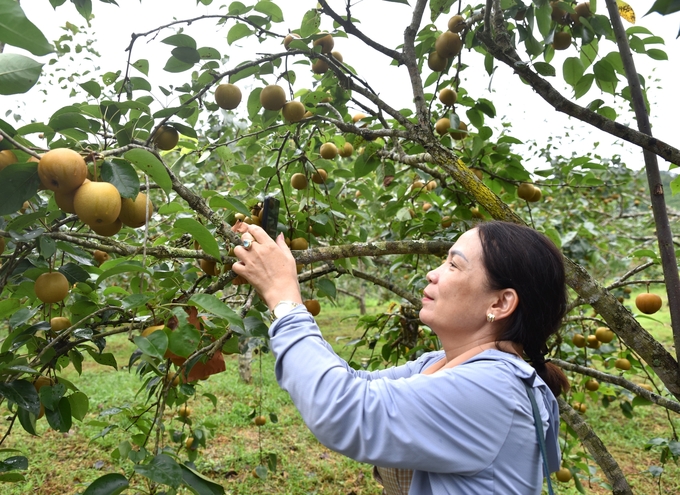
Dr. Le Thi My Ha next to a pear tree grafted with the Mi Xue pear variety. Photo: Duong Dinh Tuong.
Pear trees are present in each household in the village, with a range of 5-7 trees or as few as 1-2 trees. The brown pears weigh between 250-300 grams, while the green pears are enormous, weighing an average of 300 grams. The villagers naturally cultivate pears without the need for fertilization or care. If the pears produce fruit, they consume it; otherwise, they are left to themselves. The scientists initiated the process by fertilizing the pear trees to promote their growth. Subsequently, they managed pests and diseases, packaged the fruits, and pruned the trees after harvesting to identify the most promising mother branches for the subsequent season.
They selected delectable trees to transplant and propagate to increase the local pear area. They planted 3 hectares in Tri Phuong, Quoc Khanh, and Doi Can. These trees were well-suited to the local ecological conditions; however, additional imported pear varieties were introduced to enhance their economic value.
Dr. Ha guided me through the garden of Hoang Van Khi, which resembled a fairy tale. Below was a verdant lawn where poultry was observed foraging for insects, while pear trees atop the lawn were laden with brown fruits. Misty clouds enveloped the dark green mountain peaks in the distance. She reached out, selected a Mi Xue pear, and presented it to me. She explained that the pears are typically brown, but their skin turns pink when mature.

Mi Xue pears are soft, sweet, and juicy. Photo: Duong Dinh Tuong.
Prof. Dr. Vu Mạnh Hai (Vietnam Academy of Agricultural Sciences) nodded in agreement when I recounted my initial encounter with a Mi Xue pear: "My wife, upon tasting a Mi Xue pear for the first time, observed that, despite its unappealing appearance, its quality far exceeds that of the Korean pears sold at exorbitant prices in supermarkets." The Mi Xue pear is a delectable fruit due to its compact core and sweet, refreshing juice. Compared to the more expensive Korean pears, its quality is significantly superior, with a Brix (sweetness) level of 14-15%, as opposed to 10-11%. The fruit's hard rind facilitates long-distance transportation, and its average weight is approximately 300 grams.
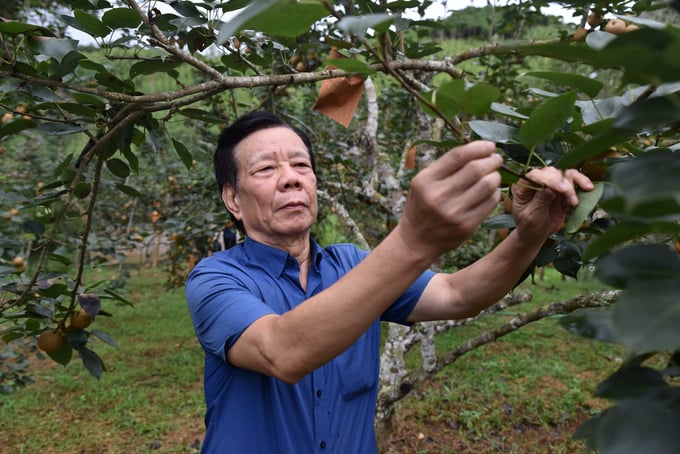
Prof. Dr. Vu Manh Hai observes a pear tree grafted with the Taiwanese pear variety. Photo: Duong Dinh Tuong.
The Vietnam Academy of Agricultural Sciences' "Development of Some Advantageous Temperate Fruit Trees in the Northern Mountainous Regions" continues the fruit tree exchange protocol between Taiwan and Vietnam cooperation initiative. Taiwan provided us with various pears and fruits, including the Mi Xue pear, while we supplied Taiwan with lychee, longan, and persimmon.
Mr. Hai elaborated, "I have a friend in Taiwan who is a fruit tree breeder named Au Xi Khoan. He is employed at the Taiwan Agricultural Research Institute (TARI)." He is highly skillful and adores Vietnam, so he chose various temperate fruit well-suited to the cold temperatures of 150-300 CU, which are prevalent in numerous northern mountainous regions. Two peach cultivars and two pear varieties were initially imported from Taiwan. Three families in Nà Khau hamlet participated in the pear planting model that year. However, the gardens were neglected, and the trees progressively withered due to one homeowner's passing and another's illness. Mr. Hoang Van Khi was the sole individual who succeeded in cultivating his garden.
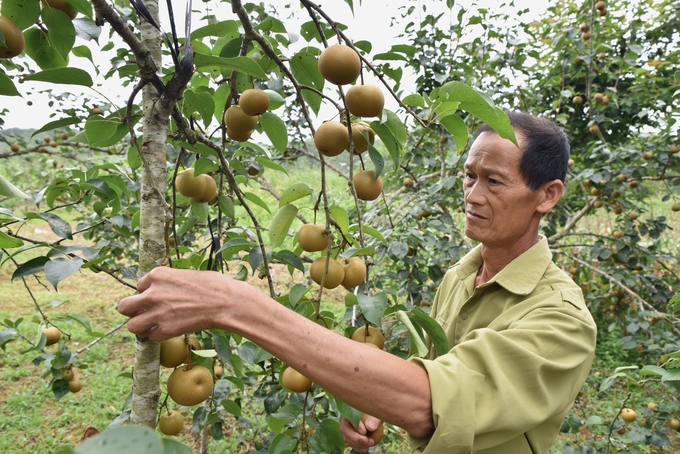
Mr. Hoang Van Khi checks Taiwanese pears. Photo: Duong Dinh Tuong.
Mr. Khi recollected that the village once had many local brown pear trees as he gazed out over his pear garden from his modest stilt house in the mountainside. The fruits were aromatic, flavorful, and reasonably priced. They were also slightly tart. And they were quite large. In addition to the brown pear, there were large and small green pear varieties; however, the latter were not widely cultivated and were nearly entirely eradicated. He consented to allow the scientists to graft new pear varieties onto the old trees, as the local pear varieties were prone to frequent mortality and inconsistent yields.
He meticulously monitored his progress to determine the efficacy of his endeavors. The imported pear varieties consistently produced high harvests each year, in contrast to the fluctuating yield of the local pears. The garden, encompassing approximately 5,000 square meters and containing 120 trees approximately ten years old, yielded 1.5 to 2 tons of fruit annually. He generated an annual profit of approximately 20-30 million VND by selling his goods at an average price of 20,000 VND per kilogram. He maintained several local brown pear trees to preserve the traditional variety. Some trees yielded as much as 300 kilograms of fruit per season, with some pears weighing as much as 1.2 kilograms. The bags were so large that he was compelled to make cuts to prevent them from tearing.
The pears were on the brink of ripeness this season, and butterflies fluttered in masses. He was anxious and unable to sleep due to the insects' presence, as he was concerned that they would cause the pears to rot. Consequently, he would venture outside twice each evening with a flashlight to pursue the insects. The butterflies were easily identifiable due to the crimson glow of their eyes in the light. He would discreetly approach and use a rubber band to flick them to the ground upon discovering them. "I am capable of withstanding adversity; however, the sight of the pears being harmed by butterflies is intolerable." Mr. Khi stated, "I am compelled to manually flick the fruits because spraying pesticides on them when they are already large is detrimental to consumers."
The scientists recommended using fruit bags to mitigate the issue of butterflies damaging the fruit. These bags safeguard the fruit from parasites and improve its appearance. Each sack is priced at approximately 350 VND and is intended for a single season. Mr. Khi nodded in concurrence.
Translated by Linh Linh
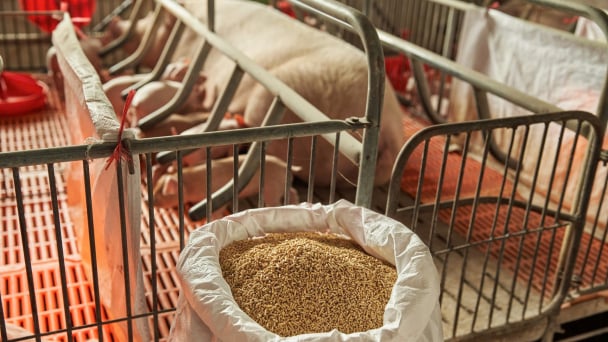
(VAN) CJ Feed&Care officially launched the FCR improvement campaign called “2025 Find Challenge Reach” in April 2025. In Vietnam, this campaign is implemented by CJ Vina Agri.
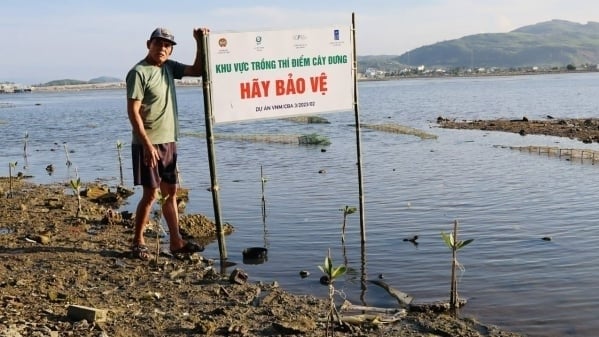
(VAN) The swamp in Pho Thanh is gradually being covered with red mangrove, creating a favorable environment for producing clean, high-quality salt.
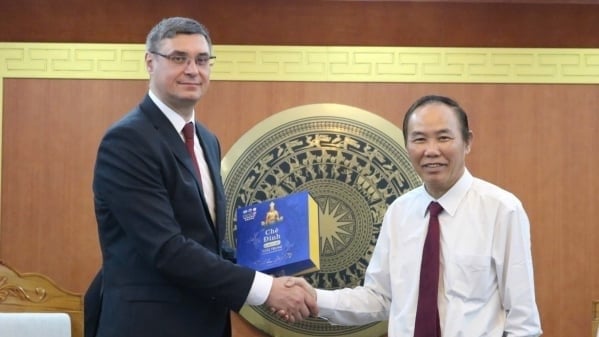
(VAN) The trade turnover of agro-forestry-fishery products is growing significantly, along with investment cooperation commitments that are opening up new development directions between Vietnam and Russia.
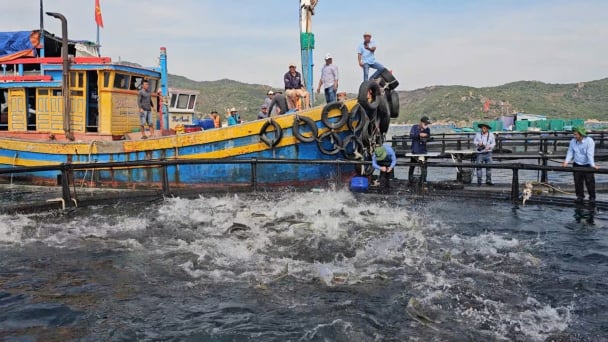
(VAN) Khanh Hoa is investing over 545 billion VND to develop 240 hectares of high-tech marine aquaculture in order to guarantee a consistent supply of seafood exports and achieve the USD 1 billion target.
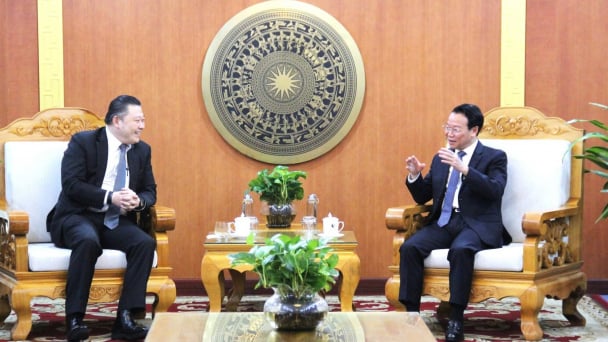
(VAN) Minister of Agriculture and Environment Do Duc Duy held a meeting with Soopakij Chearavanont, Chairman of C.P. Group, on May 15.
/2025/05/16/3800-0-nongnghiep-143756.jpg)
(VAN) Suntory PepsiCo Vietnam coordinated with the Ministry of Education and Training to implement an education program on water conservation, reaching nearly 1 million primary school students nationwide.
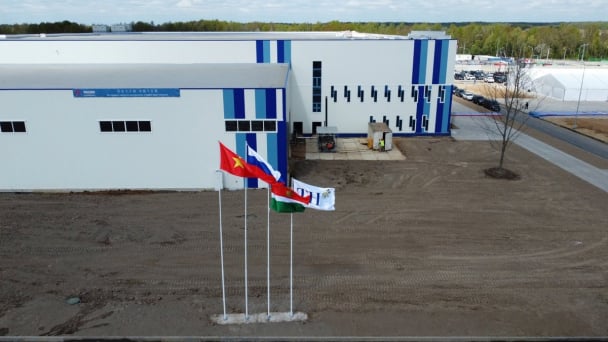
(VAN) Vietnam’s TH Group officially put its high-tech fresh milk processing plant into operation in the Russian Federation, marking a historic moment as the first TH true MILK cartons were produced in Russia.